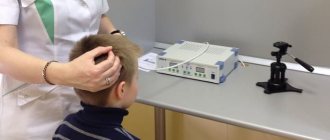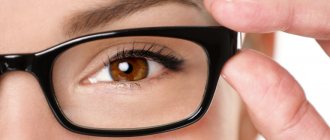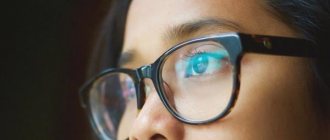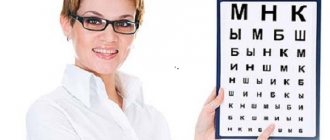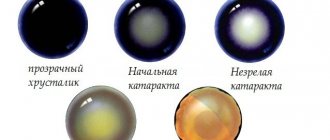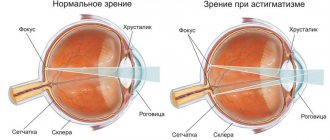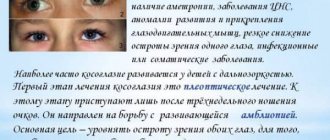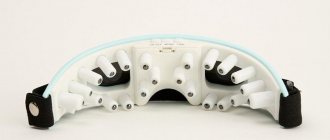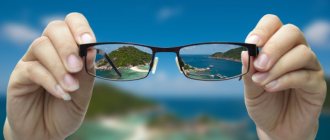Training according to Volkov
A long time ago, when there were no computers, phones and other “gadgets,” people already understood the importance of maintaining good vision.
With the help of our eyes we receive 90% of the information about the world around us, its beauty and brightness. People have come up with many exercises to preserve and restore vision. Not only training but also periods of rest are important for vision. Now that our children are constantly using phones, playing or reading on tablets, surfing the Internet through computers, it is more important than ever to take care of maintaining good vision!
A good method for restoring and preserving vision is the Volkov training complex. These workouts include periods of tension and relaxation of the eye muscles, periods of self-massage of the eyes and rest. During training according to Volkov, the patient looks at Sivtsev’s table through glasses, either with lenses with positive diopters, or with minus ones. This leads to periodic tension and relaxation of the eye muscles. Circular eye movements during exercise provide a slight massage to the eyeballs, which improves blood flow and nutrition to the eye.
10-15 such sessions can improve visual acuity by 3 – 7 lines according to Sivtsev’s table. The final result always depends on the initial diagnosis. 3-4 courses a year of such training will help maintain or even restore your child’s vision.
You should not postpone treatment for the holidays - a spasm of accommodation can turn into persistent myopia, and a weak degree of myopia into severe!
Source
Exercises for training the ciliary muscle of the eye according to Volkov
The optic ciliary muscle is responsible for moving the gaze between objects that are close or far away (this is called accommodation). Training it and relieving tension is very important for the prevention of visual impairment.
The ciliary muscle allows you to change the focal length by changing the curvature of the lens, and disturbances in its functioning will lead to corresponding visual impairment. To see both close and far objects equally clearly, train the ciliary muscle using a set of special exercises.
Exercises for training and relaxing the ciliary muscle are especially needed for those people who work at a computer for a long time or whose profession involves long-term visual work with close objects (accountants, seamstresses, welders, jewelers, stained glass artists, artists, etc.).
As with any exercise, regularity is important for gymnastics for the ciliary muscle - so try to devote at least 10 minutes to performing this complex every day.
Exercises
To fully restore vision, it is recommended to follow all the nuances of the technique:
- Gymnastics are contraindicated for people who have undergone surgery on the visual apparatus within the last 3 months;
- between exercises it is recommended to do relaxing gymnastics or palming;
- Before carrying out the technique, it is advisable to free your eyes from glasses and contact products;
- Before gymnastics, it is recommended to blink several times to warm up the muscles of the visual apparatus.
According to the professor’s method, gymnastics consists of a set of specific exercises:
Palming
Palming is performed during periods of particular fatigue of the visual apparatus. For people working behind a computer monitor, it is recommended to do gymnastics at intervals of an hour. The technique has no restrictions on age or pathologies. Palming is carried out according to the following stages:
- Actively rub your palms together until you feel a feeling of warmth.
- Place your hands in a ladle shape.
- Close your eyes tightly with your palms. In this case, the eye should be located in the center of the hand.
- Spend in this position for about 5 minutes. In this case, it is necessary to relax the visual apparatus as much as possible.
It is also necessary to open your eyes after palming following a certain sequence:
- alternately close your eyes and relax your visual apparatus under your palms;
- without opening your eyes, move your head left and right;
- massage your eyes with your fists with light pressure;
- take a deep breath and exhale;
- Blink quickly and open your eyes.
To perform the exercise correctly, the patient adheres to certain rules:
- press your palms tightly together to achieve complete darkness;
- breathe calmly;
- It is recommended to close your eyes;
- It is advisable to fix the elbows on the chest or table;
- keep your back straight;
- the head acts as an extension of the back;
- emotional relaxation is recommended when performing exercises;
- It is advisable to think about the positive moments in life for deeper relaxation.
It is advisable to carry out the exercise in a sitting position with a straight back in the absence of emotional stress.
Solarization of the visual apparatus
Vision restoration is carried out according to Zhdanov in sunny weather:
- you need to stand or sit on a chair in front of the window;
- close your eyesight and relax;
- Feet must be kept shoulder-width apart, and arms along the body;
- the chest and head are turned to the right, while scrolling on the left leg;
- after half a minute you need to turn in the opposite direction;
- on average, for an effective result it is necessary to carry out from 20 to 30 turns in different directions.
The mechanism of the restorative effect is based on the penetration of sunlight through closed eyes, which activates the activity of the retina. During periods of cloudy weather, it is possible to perform the exercise in front of a candle instead of sunlight.
Near and far
During the exercise, a person moves his gaze from objects located close to objects located far away. Charging is performed for vision correction according to Zhdanov according to the sequence:
- the patient concentrates his gaze on any distant object;
- after a while he turns his gaze to a nearby object;
- again it is necessary to concentrate your gaze on an object located in the distance;
- It is advisable to do the exercise several times.
When charging, the longitudinal and transverse muscle fibers of the visual apparatus are trained. The exercise also allows you to relax your eye muscles, which is especially necessary when working at a monitor.
Fixation
To charge, you need to sit in front of the window, where there are objects located close and far. The method is performed according to the steps:
- blink frequently and intensely, which is necessary to warm up the muscle fibers;
- suddenly stop blinking and focus your gaze on a distant object;
- then continue to forcefully close and open your eyes;
- Stop blinking and focus your gaze on a nearby object.
Additionally, you can focus on large or small objects. While performing the task, it is advisable not to stop blinking, as this will contribute to a higher degree of stress on the muscle fibers.
Pirate glasses
The essence of Zhdanov’s course is based on covering one of the lenses of glasses with a thick, black cloth. At the same time, it is recommended to carry out everyday activities while wearing a correction product, including working on a computer or reading.
While wearing such a product, each eye is trained in turn. The working organ of vision changes after half an hour.
Gymnastic exercises according to Zhdanov
According to the professor’s method, it is necessary to carry out eye gymnastics daily, or even several times a day, according to the following steps:
- Move your gaze upward. Lower it down. Repeat the exercise 5 times.
- Identical to the previous exercise, move your gaze along a horizontal line.
- Outline diagonal lines with your gaze. For example, left-up, right-down and vice versa.
- Draw a visual rectangle. You can start from any side. It is necessary to reach the size of a visual rectangle.
- The exercise is identical to the previous one, but with your eyes you draw figures in the opposite direction.
- Draw snakes with your eyes that move horizontally and vertically.
- Draw a visual bow with the eyes. It is recommended to start from the bottom left. The bow is outlined 3 times, after which it is recommended to blink.
- We draw an hourglass with our eyes. Repeat - 3 times.
- In the direction from the nose, draw a visual spiral, which consists of circles of various sizes. At the end of the exercise, you need to actively blink.
- You need to imagine a globe in front of you, which we outline with our eyes along the equator. The exercise must be repeated at least 6 times.
- To completely relax the visual organs, palming for about 5 minutes is recommended.
Gymnastics stretches the muscle fibers in the visual apparatus, which is not only a treatment, but also a prevention of eye diseases. If at the end of eye training you feel pain, then it is advisable to take a break of 1 or 2 days.
Massage of the visual apparatus
The professor recommends massage to improve blood circulation in the visual apparatus and increase relaxation. To relax the muscle fibers of the visual apparatus, perform the following movements:
- Cover your eyes completely with your palms. Try to relax as much as possible and even out your breathing. Remove your palms and remain calm for 5 minutes.
- Alternately close your eyes and relax. In the interval between movements, you need to take a break for 5 to 10 seconds. Desirable repetition - 8 times.
- Blink actively 6 to 10 times. After the movement, lower your half-closed eyelids for a few seconds.
With the help of massage, blood circulation in the area of the visual apparatus increases. To improve metabolism, the professor recommends doing the following movements with your fingers:
- Use your index and middle fingers to massage the visual apparatus in a circular motion. Fingers pass along the lower edge of the eyelid and eyebrow. It is advisable to make movements initially towards the nose, and then away from it.
- Using two fingers, massage the outer corners for 10 or 20 seconds. The pressure is not strong, rather superficial.
- During morning procedures, perform a contrast wash alternately with hot and cold water.
Gymnastics for the eyes.
(Visual exercises to relax and train the ciliary muscle).
- Exercise “Mark on glass”. Apply a mark with a diameter of 1.5-2 cm on the window glass at eye level. Stand at a distance of 30-35 cm from the window glass and look from the mark to any object located outside the window at a distance of at least 5 meters, and back. Repeat the exercise 10 times.
- Gymnastics exercise for the eyes: While sitting, press the upper eyelid with three fingers of your right hand, and after 1-2 seconds, remove your fingers from the eyelids. Repeat 3-4 times.
- Gymnastics exercise for the eyes: While sitting, close your eyes tightly for 5 seconds, then open them for 5 seconds. Repeat 6-8 times.
- Gymnastics exercise for the eyes: Move your eyes up and down, left and right with the maximum possible amplitude. The eyes should move slowly, at regular intervals, without straining. Repeat 6-8 times.
- Gymnastics exercise for the eyes: Move your eyes slowly and gently in a circle in one direction, then in the other, 4 circles in each direction. Rest for a few seconds and repeat this exercise 2-3 times.
- Gymnastics exercise for the eyes: While sitting, blink frequently for 1-2 minutes.
- Gymnastics exercise for the eyes: Standing, stretch your arms forward and look at the tip of your index finger. Slowly move your finger closer to your nose, without taking your eyes off it, until the finger begins to double. Repeat the exercise 6-8 times.
- Gymnastics exercise for the eyes: Standing, place the finger of your right hand at face level, at a distance of 25-30 cm from the eyes. Look at the fingertip with both eyes for 5 seconds, cover your left eye with your hand for 5 seconds, remove your palm and look at the finger with both eyes again for 5 seconds. Change hands. Cover your right eye and look with your left eye for 5 seconds. Repeat the exercise 6-8 times.
- Gymnastics exercise for the eyes: Sitting, close your eyes and massage your eyelids with light circular movements for 1 minute.
Very often, to relieve spasm of accommodation, a course of medications is prescribed that dilate the pupil. These drops relax the ciliary muscle and the spasm of accommodation completely disappears after 7-10 days.
The ciliary muscle of the eye, otherwise called the accommodative muscle, consists of bundles of smooth muscle fibers. These beams diverge in three different directions - meridional, radial, circular.
Spasm of accommodation
- Diagnosis of spasm of accommodation
- Treatment of accommodation spasm
Acute pathological excessive accommodation tone, causing myopization of manifest refraction and reducing maximum corrected visual acuity. In other words, this is a violation of the proper functioning of the ciliary eye muscle, which regulates the curvature of the lens, as a result of which the eye loses the ability to focus on objects located at different distances from it. Otherwise, this condition is called false myopia, as well as tired eyes syndrome.
It develops most often in adolescents 12-18 years old, but can also occur at an earlier age, rarely in adults. As a rule, emotionally labile patients suffer. It is usually preceded by severe stress or prolonged emotional stress, sometimes coupled with excessive visual stress. A spasm of accommodation may be preceded by a traumatic brain injury; cases of the development of a spasm of accommodation after refractive surgery have been described.
The disease is often bilateral, although cases of unilateral spasm of accommodation are not uncommon, and this is more common in adults. Complaints boil down to a sharp deterioration in distance vision; the ability to read, but at a very close distance, is usually preserved. In some cases, visual acuity deteriorates simultaneously - the patient can accurately indicate the day, hour and circumstances of the deterioration of vision, in others the patient, even approximately, cannot determine the timing of the decrease in vision - yesterday, a week, a month or a year ago. Under natural conditions, myopic refraction is determined, usually above 5.0 diopters, often around 10.0 diopters. In this case, visual acuity without correction is reduced to 0.2-0.3 - a discrepancy between the detected refraction and visual acuity. The use of minus lenses of increasing power very slowly improves visual acuity, and the maximum corrected visual acuity remains less than 1.0 and is usually 0.6-0.8. In this case, the patient can distinguish optotypes corresponding to visual acuity of 0.8, but make errors in the series with larger characters. In rare cases, a spasm of accommodation induces convergent strabismus. A characteristic sign of a persistent spasm of accommodation is the discrepancy between the refraction detected in natural conditions and the PZ values. The volume of absolute accommodation cannot be determined - the further point of clear vision merges with the nearest point. The volume of relative accommodation is also not determined. After instillation of mild cycloplegic drugs (even cyclopentolate!), a slight residual myopia of up to 2.0-3.0 diopters is detected, which was not previously diagnosed. After atropinization, emmetropia or mild hypermetropia is revealed. After the cycloplegia ends, false myopia returns completely. A neurologist notes functional disorders of the central nervous system. The disease can be diagnosed as optic neurosis.
There are:
- organic spasm of accommodation
- inorganic spasm of accommodation
An organic spasm of accommodation occurs, as a rule, as a result of some disturbances on the part of the body (diseases of the central nervous system, intoxication, infection). Such patients usually do NOT get an appointment with an ophthalmologist - the disorders of other organs and systems are so pronounced that the patient requires the help of other specialists. The ophthalmologist often has to deal with a spasm of accommodation induced by psycho-emotional disorders. This is an inorganic spasm of accommodation. As a rule, these are children who have a family history. Parents get divorced, have children in new families, build careers, and so on. Children feel, to some extent, abandoned. A spasm of accommodation is, to some extent, an unconscious attempt to attract attention to oneself. Although there are other causes of inorganic spasm. For example, Yuri Zakharyevich Rosenblum once described a spasm of accommodation in conscripts. The treatment was simple - demobilization from the army.
Diagnosis of spasm of accommodation
Measurement and therapeutic training of accommodation reserves (A. I. Dashevsky, 1940).
Accommodative reserve (RA) is measured monocularly. A concave lens with a force of 0.5-1.0 D is placed in front of the eye (astigmatism and myopia, including false myopia, including false myopia, are corrected completely to the point of emmetropia). In this case, the subject’s visual acuity is slightly reduced, but a small accommodation strain again increases refraction. The “eye + glass” system becomes emmetropic, and visual acuity is restored within 2-3 s (the second eye is covered with a white shield, the convergence of the eye under study is turned off). Normally, RA will range from 2/3 to the full volume of accommodation, depending on age (the full volume of accommodation at 10 years old is up to 16-20 D, at 15 years old - 13-15 D, at 20 years old - 8-10 D).
To determine the stability of accommodation, the strongest, negative lens, at which maximum visual acuity is achieved, is left in front of the eye for 3-5 minutes. With sufficient stability of accommodation, visual acuity will not change.
Accommodation training is carried out monocularly daily for 15 minutes (7-8 minutes for each eye). Find the strongest lens that the eye can overcome. After this, they begin to train the ciliary muscle, applying increasingly stronger negative lenses. When the lens improves visual acuity to 1.0, the lens is removed and immediately placed again in front of the eye. Visual acuity will be lower, but the time to recover to 1.0 will be shorter. This procedure is repeated until the time to restore visual acuity to 1.0 is close to zero. Only after this can stronger lenses be used in order to reach the age-appropriate RA norm at the end of the treatment course.
Measurement of reserve and therapeutic training of convergence and divergence for distance (A.I. Dashevsky, 1940).
The convergence reserve (RC) is determined for each eye separately at a distance of 3-5 m, that is, when accommodation is turned off. Place red glass in front of one open eye, and in front of the other - a prism, with its base facing the temple. The subject sees two lamps - red and white. With a prism power of 10-12 Δ (prism diopters) (and sometimes no higher than 1-3 Δ), both images merge into one due to the additional contraction of the internal rectus muscle of the eye caused by the fusion reflex, in front of which the prism is placed. Then they add 2-4 Δ, again achieve image fusion and do this until the strongest prism is found, which can still be overcome by additional fusional convergence.
To determine the stability of convergence, this prism is left in front of the eye for 5 minutes, removing and installing every minute. With unstable convergence, the strength of the prisms overcome decreases with every minute. The divergence reserve (RD) is determined in the same way, only the prisms should be facing the eye with their base. The fusion reserve is the sum of the reserves of convergence and divergence.
Simultaneously with accommodation training, it is necessary to conduct convergence training with the help of prisms to increase its reserves and stability: in children - up to 40-50 Δ, in adults - up to 30-35 Δ, in the elderly - up to 20-25 Δ. The strength of the prism obtained when determining the RK is increased by 2-3 Δ; the subject is trying to merge both images into one. When he succeeds, he needs to ensure that the merger occurs quickly. This way the strength of the prisms is increased to the age norm of the Republic of Kazakhstan. To avoid fatigue, do not force the gain of the prisms. Divergence training is carried out in the same way, only the prisms are placed with the base towards the nose (here you cannot increase the prism power more than 4-5 D for each eye).
Method of divergent disaccommodation. Becoming negative, convergence turns into divergence, which should reflexively cause a weakening of accommodation (divergent disaccommodation).
Artificial divergence of both eyes can be easily caused by placing the prisms with the base towards the nose. Rays of light passing through a prism are deflected towards its base. So that the rays of light can again reach the corresponding points in the central pits of the yellow spots, both eyes turn outward. A.I. Dashevsky (1973) proposed to induce, using divergent disaccommodation, a reflex relaxation of the spasm of accommodation, thereby weakening pseudomyopia.
Visual acuity and degree of myopia are determined (subjective method). If visual acuity is low, the test should be performed at half the distance from the Roth box, increasing it to 0.5, then again from a distance of 5 m.
Prisms with a force of 1-2 Δ are placed in front of each eye (without negative correction), with the base facing the nose, which causes divergent disaccommodation. After a fraction of a minute (rarely after a few minutes), visual acuity improves, and the power of the prisms can be increased (usually up to 2-3 Δ, but not more than 4 D for each eye) until the maximum increase in visual acuity is achieved.
This procedure is repeated daily, which leads to a gradual removal of pseudomyopia and an increase in visual acuity, often up to 1.0. Diverging prisms also have the same effect during training at close distances. To do this, in addition to prisms, a lens with a power of +3.0 D is placed on both eyes in a trial frame. This lens is necessary to read font No. 1 of the Golovin-Sivtsev table from a distance of 33 cm for close distance without turning on lens accommodation. The existing spasm of accommodation will determine the position of the further point of clear vision reduced in this way closer than 33 cm. This position should be found, and then the text should be positioned further a few millimeters until signs of slight clouding of the text characters appear. Thanks to divergent disaccommodation, the spasm begins to weaken. They expect visibility to improve until font No. 1 is perfectly readable, then they move the text away again and again expect improvement. Further similar training (in small steps) will lead to relaxation of the spasm.
Exercises for distance and close distances using divergent disaccommodation are an active method of reflex relaxation of accommodation and its spasm, fully consistent with the latest views on the rest of accommodation as a state of active equilibrium of antagonists in the ciliary muscle. The effectiveness of divergent disaccommodation should be increased by using the microfogging method.
Fogging method (“glass atropine”). Each eye is examined separately. A lens with a force of +4.0 D is inserted into the trial frame and asked to look at the table to study visual acuity at a close distance (25 cm). Visual acuity is determined. After 10-12 minutes, a lens 0.5 D weaker is inserted into the same frame, after which the first lens is removed. Reduce the power of the lenses until visual acuity is restored to the original level! The difference between the strongest lens, with which the initial visual acuity was achieved (sometimes even higher), from +4.0 D corresponds to the strength of the accommodation spasm removed by fogging.
Treatment of accommodation spasm
The main methods of treatment are reflexive and medicinal relaxation of the spasm of accommodation and general sanitation of the body.
1. Reflex relaxation of accommodation (no more than 6-12 months old) is achieved by the combined use of divergent disaccommodation and microfogging (optical or distant), carried out in the eye office.
2. Strengthening the tone of weakened accommodative and extraocular eye muscles. Training of RA and RK begins from the first day of treatment.
3. Therapeutic correction is very necessary. Glasses are prescribed for mandatory constant wearing in the following prescription: sph +0.5 D Pr 2Δ base to the nose (a combination of slight fogging and divergent disaccommodation. In the absence of spheroprismatic lenses, glasses with a strength of +0.5 D are given.
The second glasses are prescribed for activities at close range: sph + 3.0 D Pr 2Δ base to the nose. Schoolchildren should work in these glasses provided they develop a constant tendency to move the text as far as possible from their eyes during classes. Microfogging is prescribed for close range use at home. Bifocal glasses sph + 0.5 Δ at the top and sph +3.0 Δ at the bottom are comfortable.
4. Drug treatment. For fresh spasms of accommodation, a 1% solution of ephedrine is prescribed for children under 10 years of age and a 2% solution for children over 10 years of age. Ephedrine stimulates distance accommodation. Since accommodation at a distance and accommodation at near have a reciprocal interdependence, excitation of accommodation at a distance is possible only with relaxation of accommodation near. Therefore, the doctor should take into account that ephedrine can only have an effect with a spasm of accommodation when the spasmodic Müller muscle is not in a state of increased rigidity (as happens with old spasms).
For fresh spasms, ephedrine improves visual acuity usually for 1-3 days. Control studies also showed normalization of ergographic curves.
In the future, it is necessary to use mesaton (1% solution, 1 drop in the morning) and amizil (0.25% solution, 1 drop at night) for a long period of time, even while maintaining visual acuity of 1.0.
5. The procedure for treating fresh spasms of accommodation is as follows: micro-fogging for distance is carried out in the eye office by a doctor or trained nurse, and micro-fogging for close distance is carried out by the patient himself at home. At the same time, the student’s parents are offered the following training treatment program: morning exercises, water procedure, before leaving for school - micro-fogging training for close distances for 7-8 minutes, control over the constant wearing of therapeutic glasses for distance. During school hours, keep the text away from the eyes as much as possible with a straight seat while reading and writing. After returning from school - micro-fogging training for close range for 7-8 minutes, every 3 hours.
6. General sanitation of the body. Identification of the causes of weakening of the ciliary muscle, leading to a spasm of accommodation (intoxication, residual effects after infectious and other diseases).
Hygiene measures and especially good lighting are of great importance.
Treatment of fresh spasms of accommodation with the help of divergent disaccommodation and microfogging makes it possible to restore emmetropia and even hyperopia in 100% of patients, and if the spasms are more than a year old, only in some patients, subject to long-term treatment and elimination of instability of binocular vision, if any is detected.
Interruptions in treatment are unacceptable. Upon completion of treatment, long-term anti-relapse treatment is necessary.
The structure of the accommodative apparatus
The outer layer of the accommodative muscle contains meridional fibers that are located parallel to the sclera. They originate in the region of the chorioideae (choroid), its inner layer of elastic tendons, which in separate bundles, constantly multiplying in number, are connected by a posterior attachment to the lamina vitrea (vitreous plate of the cranial vault). Next, their path lies to the scleral spur, which acts as a fixation point. Some of the fibers are connected to the trabecular apparatus. Parallel to the surface of the sclera are elongated nuclei of muscle cells. By contracting, the ciliary muscle pulls the choroid somewhat anteriorly, justifying its name tensor chorioideae (muscle that tightens the choroid). Its other name is “Brücke muscle”, in honor of the author who first described it.
Inward from the accommodative muscle, radial muscle fibers are localized, which fan out from the scleral spur towards the ciliary processes and the flattened part of the ciliary body. The muscle bundles are separated by wide layers of connective tissue.
In the area of the internal rib of the ciliary body there are circular circular fibers - this is Müller's muscle. Muscle fibers do not form muscle mass, passing in the form of independent muscle bundles. In cross section, their nuclei appear round. Between the muscle bundles there are layers of collagen tissue with elastic and nerve fibers (the latter in large quantities). The species composition of the cells is represented by ordinary fibrocytes and pigment-containing chromatophores.
The accommodative function of the ciliary body is ensured through the combined contraction of all muscle fibers.
Accommodation function
Accommodation of the eye is its ability to adapt its internal optics to the distance to a visible object. Such adaptation is possible thanks to the work of the ciliary muscle, which, like any muscle in the human body, can be trained.
In the world of modern high technology, people living in cities are increasingly less likely to look into the distance. Computer, TV, tablets, smartphones, printed documents - the current human environment is at arm's length from him. And when driving a car in big cities, a person no longer needs to look at objects more than 5-10 meters away. The lack of need to look at significantly distant objects leads to relaxation of the ciliary muscle, which can cause unpleasant consequences. The situation can be easily compared to the work of a weightlifter who once lifted 150 kg, but after stopping training and playing chess for a long time, now cannot lift even less heavy weights. Something similar can happen to the accommodative muscle. Its complete atrophy in the absence of the necessary loads is, of course, impossible. But the former strength will certainly be lost or not gained at all if the child’s gaze from a very young age is “chained” to nearby objects.
Eye accommodation training
Performing the exercises below does not take much time, but daily exercises will very soon give a positive result - improved visual acuity.
- Prepare a small sample of text or image on a piece of paper. A banknote, postcard, or newspaper clipping is quite suitable for this. The main requirement is the good quality of the object in question and its size, which does not completely block the view. Sit by the window. Cover one eye without squeezing it shut (you can cover your eye with your hand without applying pressure). Hold the object in front of your face with your arm outstretched and look at it with an open eye. Then begin to slowly bring the object closer to your face until the visible image is completely blurred. Then, also slowly begin to move it away to its original position. Perform the exercise for at least 2 minutes, and then look into the distance for at least 1 minute. This exercise must be performed three times for each eye.
- The same props are needed to perform this exercise. It's quite similar to the first one. The difference is that for training, you should look at the object for 2 minutes from a minimum distance of clear vision (near point of clear vision). Then, relax and look out the window at the horizon for 1 minute. As in the first case, the exercise is repeated three times for each eye alternately.
- You need to select an object located at a sufficient distance outside the window that can be clearly seen. Place the existing sheet of text or postcard as close to one of the eyes as possible, so that it can be comfortably viewed, and cover the other eye. Then you need to do it within 10 seconds. alternately look first at the sample, then at the selected object outside the window. The exercise is repeated for 5 minutes for each eye. At the end, it’s worth looking out the window at the horizon for about three minutes.
By contacting the Moscow Eye Clinic, each patient can be sure that some of the best Russian specialists will be responsible for the results of treatment. The high reputation of the clinic and thousands of grateful patients will certainly add to your confidence in the right choice. The most modern equipment for the diagnosis and treatment of eye diseases and an individual approach to the problems of each patient are a guarantee of high treatment results at the Moscow Eye Clinic. We provide diagnostics and treatment for children over 4 years of age and adults.
Our doctors who will solve your vision problems:
Fomenko Natalia Ivanovna
Chief physician of the clinic, ophthalmologist of the highest category, ophthalmic surgeon. Surgical treatment of cataracts, glaucoma and other eye diseases.
Yakovleva Yulia Valerievna
Refractive surgeon, specialist in laser vision correction (LASIK, Femto-LASIK) for myopia, farsightedness and astigmatism.
Gigineishvili Darejan Nugzarevna
A retinologist, a retina specialist, conducts diagnostics and laser treatment of retinal diseases (dystrophies, ruptures, hemorrhages).
You can find out the cost of a particular procedure or make an appointment at the Moscow Eye Clinic by calling in Moscow 8 (499) 322-36-36 (daily from 9:00 to 21:00) or using the ONLINE REGISTRATION FORM.
Systematic influence on the accommodation apparatus in order to prevent the onset and progression of myopia allows one to normalize the tone of accommodation, increase the performance of the ciliary muscle, enhance the metabolic activity of the cells of the ciliary body, and improve the hemodynamics of the eye.
Indications for functional treatment for myopia are: progressive myopia, relative amblyopia in congenital myopia, low values of ZOA and OAA, PINA, asthenopic complaints.
Contraindications include: inflammatory diseases of the eye and its adnexa, young age of the child, poor tolerance of procedures, convulsive readiness.
Home accommodation training is prescribed 4 times a year and is often combined with other treatment methods.
1). Exercise “Mark on glass” is carried out with glasses, daily, once, for 1 month. The first three days, the duration of each exercise is 3 minutes, the next three days - 5 minutes, on the remaining days - 7 minutes.
2). The exercise with a “Racket” or a home accomodo trainer is carried out for 7 - 10 minutes. for each eye at 10-minute intervals. Against the background of exercises for 1 month. Patients are recommended forced instillations of r-ra taufon 4%: 1 drop 4 times with an interval of 10 minutes and instillations of r-ra irifrin 2.5%, 1 drop every other day at night.
3). Home optical-reflex exercises using optical disaccommodation simulators (TDO - “Zenitsa”) are carried out for 5-10 minutes 4-5 times a week during the period of risk of developing myopia.
4). Physical activity, mainly outdoor activity (swimming, badminton, tennis, gymnastics, dancing, slow middle-distance running, etc.) is recommended for uncomplicated myopia.
For myopia complicated by PVHRD, physical exercises involving jumping and lifting weights, running against the clock, somersaults, and pull-ups are not recommended.
Optical - reflex training of accommodation
1). Accommodation training according to E.S. Avetisov - K.A. Mats is carried out binocularly under conditions of full correction, once in the first 3 days, twice on the remaining days. At very low starting values of relative accommodation, exercises are carried out in a gentle mode: larger text is used for reading, exercises are shortened in time, and negative lenses are changed in increments of 0.25 diopters. To clarify submaximal loads, the volume of relative accommodation is determined every 3 days. The optimal criterion for the effectiveness of such training is an increase in VA. The course consists of 15 - 20 workouts. To consolidate the effect, it is recommended to carry out the previously described home exercises.
2). Optical microfogging method according to A.I. Dashevsky is performed for each eye separately. The duration of one workout is no more than 15 minutes for each eye. The course of treatment is 10 training sessions.
3). Method of divergent disaccommodation according to A.I. Dashevsky. A necessary condition is stable binocular vision, a contraindication is exophoria for distances greater than 6.0? diopter
4). The “swing” method according to V.V. Volkov - L.N. Kolesnikova is used if it is not possible to achieve an increase in uncorrected visual acuity using the methods described above. Treatment is carried out monocularly under conditions of full distance correction.
5). Ophthalmomyosimulator - relaxer "Visotronic". Mechanism of action: the relaxing effect of “glass atropine” or microfogging on the ciliary muscle due to positive spherical and cylindrical lenses, as well as the divergent disaccommodation effect caused by prisms.
Section 9. Treatment of myopia
9.1. Hardware (functional) treatment of myopia
Systematic influence on the accommodation apparatus in order to prevent the onset and progression of myopia allows one to normalize the tone of accommodation, increase the performance of the ciliary muscle, enhance the metabolic activity of the cells of the ciliary body, and improve the hemodynamics of the eye. Indications for functional treatment for myopia are: progressive myopia, relative amblyopia in congenital myopia, low values of ZOA and OAA, PINA, asthenopic complaints. Contraindications include: inflammatory diseases of the eye and its adnexa, young age of the child, poor tolerance of procedures, convulsive readiness.
The meaning of accommodation
Many outstanding scientists and doctors have studied visual impairments, among them our compatriot Eduard Sergeevich Avetisov, who devoted many years to the study of myopia and strabismus.
As a result of his work, he developed a comprehensive methodology for strengthening and developing all structures of the eye, which is based on training the accommodative ability of the lens. The lens is a tiny clear lens that refracts light rays and focuses them on the sensitive nerve tissue of the retina. With the help of muscles, it can change the radius of curvature of its surface, providing optimal refraction in different conditions. Thus, the eye perceives objects located near a person and in the distance differently. This process is called accommodation .
For a number of reasons, the lens loses its ability to adequately respond to changes in distances. Spasm of accommodation leads to deterioration of vision, especially at long distances. In ophthalmology, this pathology is called myopia .
Several sets of exercises have been developed to correct and improve eye accommodation - these are the Utekhin, Dashevsky, Avetisov-Mats systems. Each of them is effective and can prevent vision deterioration, and in some cases even improve it. But they all require special equipment, a large number of lenses with different optical powers and medical knowledge to properly organize the process. In the classic version, these trainings take place in a clinical setting under the supervision of a physician .
But the opportunity to preserve and improve vision should be available to every person. exercises were developed , which now bear the name of Dr. Avetisov.
Doctor Volkov's diet: unscientific and harmless
Author:
Bondar Yulia
9 minutes
8995
Dr. Volkov's diet is quite popular, its adherents glorify Dr. Volkov and advertise the unprecedented results of his diet after just three months of its use. What exactly is its difference from dozens and even hundreds of other diets? And who is Dr. Volkov himself, who does not allow himself to be photographed, practically does not give interviews and does not meet with journalists?
Who is Dr. Volkov
Doctor Volkov. Photo: YouTube
The mysterious Doctor Volkov is a real person of flesh and blood. He is 63 years old and a doctor. Anatoly Volkov graduated from the 2nd Moscow State Medical Institute named after. N.I. Pirogov in 1981, specializing as a pediatrician. He completed his internship in pediatrics at Children's Hospital No. 9 named after. Dzerzhinsky. For more than 11 years he worked as a visiting pediatrician at the State Healthcare Institution of the Moscow City Executive Committee. Since 1997 he has been engaged in scientific work. He has a patent for invention No. 2152616 “Method for diagnosing the individual sensitivity of the body to food products” dated 05.19.1999, as well as a patent for invention No. 2185178 “Method for Correcting and optimizing the nutrition of patients to improve the health of the body and reduce excess weight (IgG4)” dated 2001 . Author of the book “The Logic of Health” and “8 Principles of Health”. And for about 20 years now, Volkov has been successfully engaged in private nutritional practice, and even created his own clinic, “Ekolabmedtest”, in 2000 with the help of grateful patient sponsors. Among his clients are deputies, governors, actors, and representatives of Russian show business. His name has been passed on to each other as a precious recipe for a healthy life for the second decade.
Features of Dr. Volkov's diet
The Volkov diet is one of the varieties of separate nutrition systems. It does not contain general recommendations on the choice of products; the diet is compiled individually. According to its author, different types of food require special enzymes and different times to digest. Therefore, you should not mix products that differ too much in the specified parameters in one go. Volkov's diet rules:
- protein and carbohydrate foods are not consumed together;
- You should eat only when you feel hungry;
- You can choose any diet, but at least 2 hours must pass between meals;
- You need to drink 3 liters of water per day, with the first liter before breakfast;
- You can only drink water or green tea with meals. Other drinks are allowed 30 minutes before a meal or an hour after it;
- eat only environmentally friendly products: subject foods only to minimal heat treatment, cook as quickly as possible;
- prepare dishes using dietary methods - boiling, steaming, baking in the oven and grilling;
- the diet should be as varied as possible;
- you need to carefully monitor the body’s reaction to food, refusing foods that make you feel worse after eating them;
- regularly take a biochemical blood test to monitor the body’s reaction to certain foods;
- you need daily physical activity, dousing yourself with cold water before going to bed.
- At Dr. Volkov’s clinic, each patient undergoes a serological blood test. An extract of the food product is added to the whole blood sample of the subject, the erythrocyte sedimentation rate per hour is measured in the experiment and in the control, the difference between the first and second is determined, divided by the sedimentation rate in the control, and if the value obtained is more than 0.2, hypersensitivity to this is diagnosed. food product.
Based on the characteristics of the erythrocyte reaction, so-called immunoantagonist products are identified. The patient is given a “red list” - he is now prohibited from eating these foods for three to four months. Recommended products are included in the “green list”, but here, too, everything is not so simple. Volkov himself or one of his employees will certainly cross out from there all types of sugar, honey, grapes (and therefore wine), yeast (and therefore beer) and almost always wheat (and therefore vodka). Then a diet is drawn up: in the morning - fruits and cereals; during the day - cottage cheese, eggs, nuts, fish; in the evening - meat. It is strictly forbidden to mix proteins and carbohydrates. After some time - re-analysis and new lists.
Everything that the patient is allowed to eat according to the results of the analysis must be eaten strictly separately. For example, if you drank water, don’t eat right away; if you ate fish, don’t think about fruit. Breaks between meals range from half an hour to two. However, there is no strict ban on eating after 18:00, although the food offered is very unappetizing. Smoked, salty, fatty, fried and sweet foods are excluded. “The situation when medicine fights the body,” says Volkov, “is fraught with the fact that it can be accidentally defeated. What happens next is clear. My tasks are simple. Firstly, the patient must change some of his eating and culinary habits, since they have already led to unsatisfactory results. Secondly, he must learn to listen to himself, and not lustfully study the menu in a restaurant. Thirdly, force your own body to remember that it can self-regulate. Losing weight is not a goal, but only a side effect of overall health. And it happens the faster the more excess weight has accumulated. My patients lose tens of kilograms without the slightest harm to their health. The excess water just drains away.”
Photo: Shutterstock/FOTODOM
All products allowed for consumption are divided into six types, each of which cannot be eaten together under any circumstances. The principle of separate nutrition, which underlies the Volkov diet, was developed by the American Herbert Shelton. The first group includes dairy products, the second - meat and fish, the third - vegetables and legumes, and the fourth - fruits and nuts. Watermelon and cantaloupe form two separate groups. The doctor recommends that everyone, without exception, avoid fried, smoked, salted foods, foods with preservatives (including juice in packages), dyes and other additives. You should even give up chewing gum. You should not eat stewed meat, fish, or drink coffee before meals.
A rare patient, after reading Shelton’s works, will have enough willpower to independently refuse prohibited foods. The attractiveness of Volkov’s technique is based on the fact that, according to the doctor, the diet for each client is strictly individual, it is developed based on the results of a blood test. Each person who donates blood has a personal consultant doctor who monitors how the recommendations are followed and supports the patient at a time when he has doubts about the correctness of the chosen path.
Which celebrities advertise Dr. Volkov's diet?
Lawyer Andrei Makarov became the face of the Doctor Volkov brand. Galina Volchek and many actors of the Sovremennik Theater, Valentina Matvienko, Larisa Rubalskaya, Olga Bakushinskaya, Mikhail Shufutinsky, Anatoly Chubais, Mikhail Lesin, Mikhail Shvydkoy, Dmitry Rogozin and many others spoke about the fact that they are “losing weight according to Volkov”. Among his followers are the clientele of World Class sports clubs and Azbuka Vkusa supermarkets.
What is the secret of the popularity of the Volkov diet?
Dr. Volkov’s dietary recommendations do not contradict all previous achievements of classical dietetics. Frankly speaking, everything is quite banal. So what is the secret to the success of his method? Apparently, the realization that every three months they have to shell out quite a lot of money for “losing weight with the stars” forces patients to strictly curb their appetite and give up unhealthy foods in favor of buckwheat and vegetables. Any local doctor from the province can prescribe exactly the same diet with the same restrictions, and for free. But who will take his simple recommendations seriously and strictly follow them? Meanwhile, the same diet, which introduces one to the circle of the “chosen ones” through serious expenses, works wonders. The principle “what works is what works” was first voiced by Freud, who almost 100 years ago said that in order to achieve results, the patient must pay for treatment, and pay dearly.
Criticism of experts
According to the chief hematologist of Russia, director of the Hematological Research Center, Academician Andrei Vorobyov, Volkov’s diet has nothing to do with science and blood. “A food product in itself cannot be a source of antigens, and the erythrocyte sedimentation rate, which “is an indicator of the tolerability of a particular product,” only indicates the presence or absence of an inflammatory process in the body and has nothing to do with allergic reactions. We can firmly say that all these fashionable dietary recommendations are one hundred percent devoid of any scientific or practical justification.”
Representatives of the Ministry of Health also have a negative attitude towards the practice of Dr. Volkov and other clinics that develop diets based on the results of a patient’s blood test. “The ministry has not considered the method development of a blood test diet and, therefore, is not permitted,” said Nina Pyzheva, head of the department for the implementation of scientific developments of the department of scientific research medical institutions of the Ministry of Health of the Russian Federation. — We cannot guarantee that it is safe for human health. According to the basic legislation of the Russian Federation, all treatment methods must obtain permission from the ministry.”
According to Nina Pyzheva, permission to operate the clinic was given by a licensing authority, which is not subordinate to the ministry: “Now any clinic can obtain a license without the knowledge of the Ministry of Health. In this case, the company simply could not indicate this method in the description of its activities. Therefore, the licensing authority did not require permission for it.”
The Institute of Nutrition of the Russian Academy of Medical Sciences treats such diets with caution. Leading researcher at the clinical nutrition clinic, Mikhail Gurvich, believes that “a blood test cannot be a leading factor in developing a diet.”
“There are a lot of techniques that help patients lose weight, but it is unknown how this affects their health,” says Gurvich. — At our institute, Dr. Volkov’s experience is unknown, so it is impossible to say how safe it is for patients. It is important to remember that no diet should worsen a person’s condition, even temporarily, as happens with Volkov.”
Are the benefits of separate meals a myth? Shelton and Volkov
Separate nutrition has long been included in the category of harmful myths about nutrition. Nature initially programmed the human digestive system for a mixed diet. A set of enzymes produced by the stomach and pancreas allows the simultaneous digestion of proteins, fats and carbohydrates. The myth of separate nutrition arose under the influence of the works of Dr. Hay in 1930, which were refuted by classical dietetics in the early 50s of the last century. In the West today, the most famous proponent of the theory of separate nutrition is Herbert Shelton, who devoted 40 years to the study of diet and orthotrophy (the science of proper nutrition). The “Bible” of separate nutrition, Shelton’s famous book “Proper and Harmful Food Combinations,” was first published on July 10, 1928, and is still very popular.
From the book Mazurkiewicz SA. Encyclopedia of misconceptions. Nutrition. Moscow, Publishing house "Eksmo", 2005:
“Shelton’s theory is also refuted by the fact that there are practically no products consisting of one protein (fat, etc.). Pure protein can only be found in eggs, fat in sunflower oil, and carbohydrates in sugar. Everything else is a mixture.” Head of the Department of Metabolic Diseases of the Institute of Nutrition of the Ministry of Health of Russia, Doctor of Medical Sciences Yu. P. Popova o
Photo: Shutterstock/FOTODOM
Investigative experiment
Back in 2009, a group of journalists decided to conduct a kind of check at Dr. Volkov’s clinic. They asked the same person to be tested. But not after three months, as Dr. Volkov recommends, but after three weeks. And the journalists found themselves with two completely different lists of prohibited and permitted products. However, both the first and second diets contained so few carbohydrates and so much fiber that losing weight with either of them would have been inevitable. However, absolutely any diet recommends excluding fatty, salty, smoked foods, and also using less fast carbohydrates and more fiber in your diet, and it’s completely free.
Pros and cons of the Volkov diet
This diet certainly has its advantages. In essence, Dr. Volkov operates in a standard way: he returns his patients to healthy eating habits - the only real way to lose weight. His recommendations correspond to all the achievements of classical dietetics, so weight loss can be very significant.
There are quite a few disadvantages to this diet, and the most important of them is the price of the recommendations. In addition, most doctors consider drinking 3 liters of water daily to be excessive and more harmful to health than beneficial. Cold dousing, which Dr. Volkov recommends in addition to the diet, has a tonic (invigorating) effect, so the advisability of performing this procedure before bed is questionable.
Recommendations for those who have decided to “lose weight according to Volkov”
Before starting a diet, you should prepare - find a nutritionist familiar with the Volkoff system, and a laboratory where you can regularly take blood tests. To create an individual diet, it is proposed to focus on the results of regularly taken biochemical blood tests, adjusting the menu depending on the indicators. Obviously, this requires a diet under the supervision of a specialist, which is not always convenient and also expensive. The Volkov diet is not recommended for kidney disease.
Employees of the Volkov clinic warn that at the beginning of the diet, a short-term exacerbation of some chronic diseases is possible. Therefore, you need to monitor your condition after starting a diet with special attention.
Gymnastics for the eyes
Exercise for the eyes according to Avetisov trains and strengthens the eye muscles, and also improves blood supply to all structures of the organ. The main emphasis is on training the accommodation of the lens when looking at objects at different distances.
Physical education can serve both as a prevention of myopia and as a general strengthening therapy for the visual system. You can use it to relax in between hard work at the computer or reading.
Complex efficiency
Avetisov’s gymnastics for children is most effective. The child's eyes are still quite flexible and easily respond to corrective therapy . At a young age, it is much easier to “pump up” the muscles of the ciliary body that control the lens and “teach” them the correct movements.
In adults, the technique is mainly used as a preventive measure against the onset or worsening of myopia. Quite often there is a real improvement in vision, but this is not the main goal of gymnastics and cannot be guaranteed.
The effectiveness of the method is higher when correcting acquired pathologies. If the visual impairment is congenital, exercise will most likely not be able to affect its causes.
The benefits of using the complex can be increased significantly if you combine gymnastics with proper nutrition and a healthy lifestyle in general. It is important to maintain lighting conditions and alternate periods of work and rest, preventing your eyes from becoming overly tired.
Like any other workout, Avetisov exercises can only be effective if performed regularly. Pronounced improvements are observed only after 6-9 months of systematic training. The result cannot be quick, because the problem did not appear in a couple of days.
Execution technique
The exercises are divided into three subgroups, each of which has a specific effect on the structures of the eye. It is recommended to follow the order, starting with the first complex, then moving on to the second and third.
Basic rules of execution:
- Exercises should be done daily, morning and evening, and throughout the day as needed.
- All exercises are performed calmly, slowly, thoughtfully, with a straight back and even breathing. It is important to maintain good posture as it promotes abundant blood supply to the brain and eyes respectively.
- You should start exercising with 4-5 repetitions of each movement, gradually increasing this number to 10-15 times when the body gets used to the load.
- Don't strain your eyes. If you experience discomfort, you need to pause and give yourself a rest.
Improved blood circulation
Tasks in this group prepare the eyes for stress, improve nutrition of all organ structures, and stimulate the movement of intraocular fluid. They should be performed in a sitting position.
- Close your eyes tightly, wait 3 seconds, open your eyes again, look ahead for 3 seconds. Repeat the cycle 4-5 times.
- Blink as fast as you can for 15-20 seconds. After this, rest for 10-15 seconds, do not blink. Do 3-4 repetitions.
- Massage your closed eyes with your index fingers. Light circular movements will help the muscles relax.
- Apply gentle pressure to the closed eyelid with three fingers for a few seconds. 3-4 pressures will relieve tension from the deep muscles that rotate the eyeball.
- Press your index fingers into the skin in the middle of your eyebrows so that you feel resistance when you close your eye. Blink slowly 5-6 times, overcoming it.
These wonderfully relaxing manipulations can be done together or separately at any time when you feel fatigue or pain in the eyes, for example, between exercises of the second and third groups.
Muscle strengthening
The exercises are performed while sitting, with the gaze directed forward in the starting position. When moving the eyes, the head should remain in place without turning. Each item in the description corresponds to one cycle, which must be repeated from 5 to 15 times, depending on the level of training.
All movements of the gaze should be performed slowly, being sure to fixate for a moment at the end points and paying attention to everything that is between them. Take your time while doing the exercises.
- Look as high as possible, then slowly lower your eyes down.
- Move your gaze to the left, trying to see your left ear, then smoothly move your focus point to the right and try to see your right ear.
- Raise your eyes as high as possible to the left, look down to the right. Do the required number of repetitions, then change the diagonal.
- Describe circles of different diameters with your gaze, from the smallest to the largest possible. Perform a clockwise rotation approach, then reverse direction and repeat.
Once your eyes get used to the strain, you can add additional shapes to move your eyes. For example, you can move your gaze along a square, a rhombus, a figure eight, an infinity sign, or a five-pointed star. Any unusual muscle movements are useful.
Accommodation training
These exercises should be performed standing with your back straight. Each of the cycles can be performed in three versions: with two eyes, only with the left and only with the right eye. The inactive eye should be covered with the palm of your hand or thick paper, but not squinted. Perform each cycle 10-15 times. Exercises should not strain your eyes, make sure that your facial muscles are relaxed.
- Extend your hand with the pencil clamped in front of you so that it is positioned vertically. Instead of a pencil, you can raise one finger up. Look at it for a few seconds. After this, move your gaze into the distance, to the horizon, and also linger.
- Extend your arm again, lift one finger. Smoothly bring your hand closer to your face until you touch your nose with your finger, then also smoothly move it back. The gaze is always focused on the finger. Thus, we follow an object, the distance to which is constantly changing, and the lens is forced to adjust in order to see clearly.
- Find a clean, transparent window facing the street and draw a dark dot of small diameter on it at eye level. Move your gaze from the point to some distant object outside the window and back. Do it for 5-7 minutes, this perfectly trains accommodation and relaxes the eyes.
Bates exercises to relax the eye muscles
Palming
According to Bates, the cause of all refractive errors is tension in the psyche and eye muscles. Therefore, the elimination of these anomalies is achieved by resting and relaxing the eyes. The word “Palming” is derived from the English “Palm” (palm). You need to cover your eyes with your palms folded in a “house” (so that your eyes can open and close freely under them). The fingers are straightened and crossed on the forehead, so that the bases of the little fingers cross on the bridge of the nose. Relax your elbows, wrists, and fingers. To do this, you can place your elbows on the table or on your knees. There should not be a single crack into which light would enter. The head should not be thrown back or tilted forward.
You need to try to see absolute blackness, but you should not pay attention to your eyes, try to feel them, you need to imagine something pleasant, for example, a beautiful landscape.
The duration of the exercise is 3-5 minutes. It is recommended to perform it every time you feel tired and tired of your eyes. Even 10-second periodic procedures will give their effect over time.
Memory
To relax your visual organs faster and better, Bates advises while palming to think about something pleasant and imagine beautiful pictures. Moreover, memories can be not only visual, but belong to all senses (sounds, smells, etc.). This perfectly relaxes the psyche, and at the same time the muscles of the eyes relax.
Exit from palming can be done as follows: alternately close your eyes and relax your closed eyes under your palms, then remove your hands from your face, shake your head from side to side, then open your eyes and blink quickly. This improves blood circulation.
Mental image
Usually, during palming, light spots, residual light images, float in front of your closed eyes. To see an absolutely flat black field, you can imagine various black objects. For example, a black curtain in a theater that gets darker as the lights go down, or spilled black paint that gradually spreads and covers up all the bright areas.
Central fixation
In the very center of the retina, located on the back surface of the eye, there is a fossa, the so-called “yellow spot”, or macula. This is the most light-sensitive part of the human eye. The normal eye always sees the central part of the object being viewed better than the rest of its parts. That is, peripheral (side) vision is less clear, and this is normal. But in all people with refractive errors, central fixation is impaired. When vision is imperfect, the eyes try to see everything in the field of vision equally well at the same time.
Fixation exercises are done as follows: first, an object is selected, then some detail of this object, then a smaller detail, etc. For example: go to the window, blink, look at the street, as if you see everything at the same time and nothing. Without stopping blinking, choose a house and start looking at it more closely. Then choose a window in this house. Then part of the window frame. Thus, the eye gradually becomes fixated on smaller details, and surrounding objects are seen worse. The exercise is performed without glasses!
Other exercises performed according to the same principle:
- Crowd at a bus stop - a man in a jacket - his jacket - a button on his jacket;
- A page of text - a line in the text - a word in a line - a letter in a word.
Optima and pessimums
According to Bates, there are objects that are seen well by most people and objects that are seen poorly, regardless of the state of vision. Such objects are called optima and pessimums, respectively. The vision test chart is a pessimum for most people. If a person perfectly sees all the letters in the table, then he can see almost everything.
At the same time, among the letters there are optimal letters and pessimum letters. Each person may have their own, but there are also some general patterns. For example, optimal letters are such as O, T, R. Many people distinguish them well even in small ones. And the pessimums are Zh, Shch, Yu, Y, M. They are easy to confuse with each other, and even a person with normal vision sees them worse than the optimal letters. Therefore, it is recommended, when leaving the palming, without opening your eyes, to draw large printed pessimum letters with your nose, the ones that you see the worst.
Solarization
Light is essential for healthy eyes. Solarization can be done using candles, lamps, etc., but the most natural and optimal option is sunlight.
- Solarization on a candle. Place a candle or lamp in front of you and turn off the main light. Sit in front of a candle and turn your head and eyes from side to side, while your eyes are motionless, turning only with your head and looking straight ahead. There is no need to pay any attention to the candle and focus your gaze on objects flying past. The candle should move past freely.
- Solarization in the sun. Go out into the sun, close your eyes and expose your face to the sunlight. Turn your head to the right and left, you can help yourself with your body. When your eyes get used to bright light, you can briefly lift the upper eyelid of one eye, while looking down, so that the sun shines on the sclera. Then repeat the same with the other eye. When the slightest tension appears in your eyes, you need to blink. Solarization must be carried out strictly in doses.
After solarization you need to do palming. In general, it is recommended to end any eye exercises with palming. At the same time, people with myopia need to imagine that their transverse eye muscles relax, and those with farsightedness relax their longitudinal ones.
Gymnastics for the eyes
Any lesson should begin with palming, and then train the relaxed eye muscles. If palming can be done as long and often as desired, then eye exercises can be done no more than 3 times a day, in doses and gradually increasing the load. Gymnastics, like all exercises in general, is done without glasses. The face is motionless, only the eyes move. Sudden eye movements are prohibited.
- It’s easy and quick to blink your eyelids alone without squinting your eyes. Next, this should be done after each exercise.
- Move your eyeballs up and down.
- Move your eyes left and right.
- Raise your eyes to the right and up, then lower to the left and down. Then perform another diagonal: left-up – right-down.
- Draw a square with your eyes: left-up – right-up – right-down – left-down. Draw a square in the other direction.
- Imagine a dial in front of your eyes. Raise your eyes to “12 o’clock” and smoothly move them in a circle: “3 o’clock”, “6 o’clock”, “9 o’clock” and twelve again. Blink and perform the exercise counterclockwise.
- Draw a “snake” (sine wave) with your eyes. Move your eyes up and down, while your gaze gradually moves from left to right. Then perform the exercise from right to left.
- Draw a horizontal “figure eight” or an infinity sign with your eyes: eyes left-up – diagonal – right-up – diagonal. Then draw a figure eight in the other direction.
- “Spiral”: first draw with your eyes a small circle in the center, then a larger one, an even larger one, etc., the largest one - along the side walls, floor, ceiling. Blink.
- Imagine that in front of your eyes there is a vertical glass pipe on which a rope is wound from bottom to top. You need to make five such turns.
- Imagine that in front of your eyes is a horizontal glass pipe, on which five coils of rope are wound in a spiral in the same way.
- "Globe". Imagine that there is a large glass globe in front of your eyes, and you need to spin it, moving your eyes along the equator.
On the subject: The most important substances that restore visual acuity
